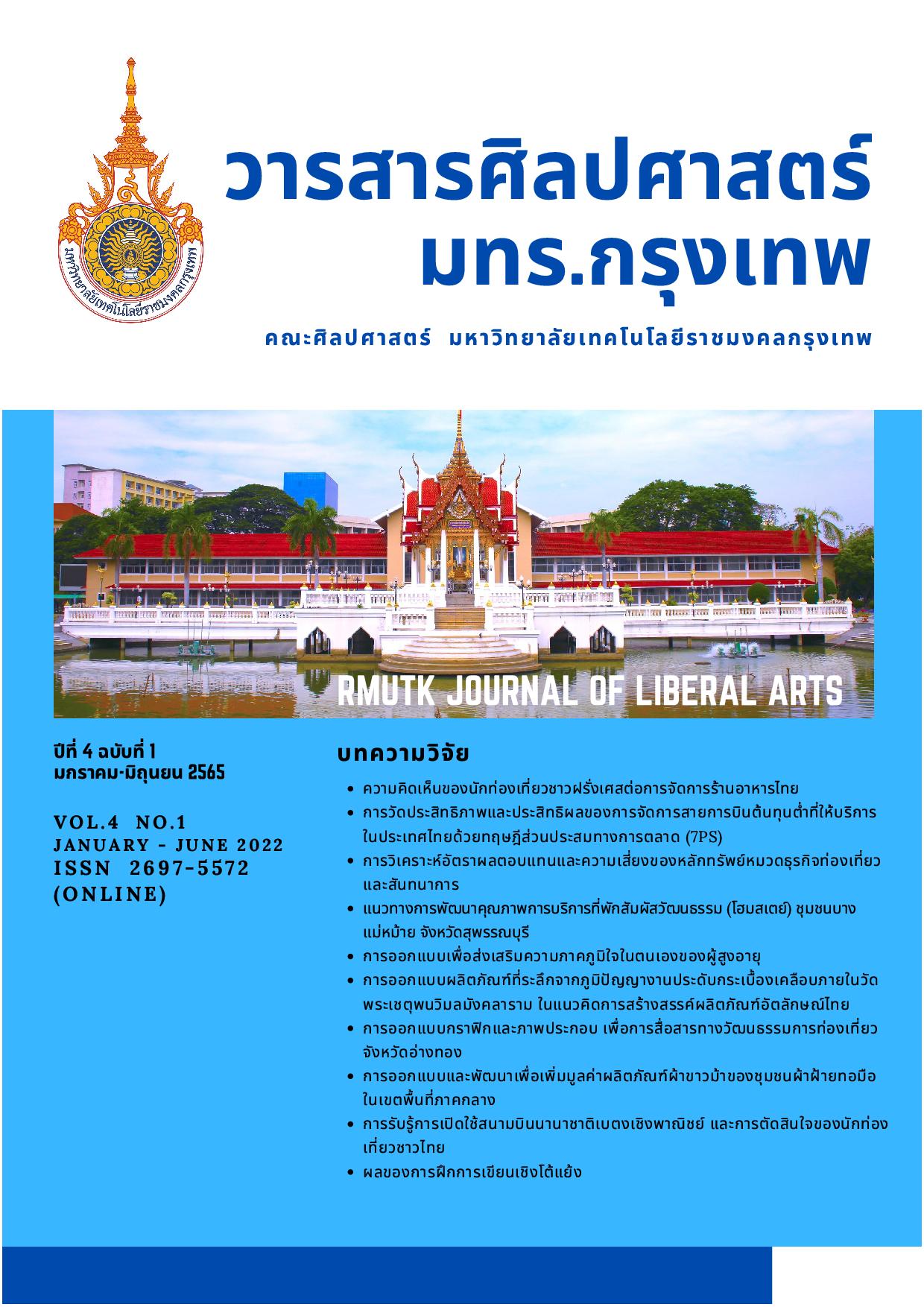A GRAPHIC DESIGN AND ILLUSTRATION FOR CULTURAL COMMUNICATION TOURISM IN ANG-THONG PROVINCE
Main Article Content
Abstract
This research has 3 objectives which are: 1) to study the general information in Ang-Thong, Sign-function theories/ semiotics, design concepts, and public relations themes to promote the cultural tourism in Ang-Thong, 2) to make graphic design emblems and illustrations of cultural tourism, and 3) to evaluate the satisfaction towards the graphic design emblem and illustration of cultural tourism in Ang-Thong. The research method is divided into 3 phases relating to the objectives. The population of this research and development are Thai and international tourists in the cultural tourism area of Ang-Thong. One-hundred samples were selected by using purposive sampling method, and Yamane’s calculation formula was applied. The tool of the research is an evaluation form to assess the satisfaction towards the graphic design and illustration. The process of the emblem and illustration design includes the interpretation from Ang-Thong provincial slogan into signs. It was divided into 2 groups of designs which are 1) visual graphic illustration and 2) font design. The result declares that overall satisfaction towards the graphic design emblem and illustration of cultural tourism in Ang-Thong was at a high average (=4.97, SD=0.17) in the aspects of the elegance and element of emblem and illustration at the high level (
=495, SD =0.18), and communication and interpretation of the signs at the high level (
=4.98, SD=0.15). The results of this research can be applied and developed into various designs, in order to enhance and promote uniqueness of goods, packages, and community products in Ang-Thong. The designs, fonts, and background can be redesigned with variety of cultural contemporary techniques of art to reaffirm feelings and memories of the community.
Article Details

This work is licensed under a Creative Commons Attribution-NonCommercial-NoDerivatives 4.0 International License.
References
กิตติศักดิ์ กลิ่นหมื่นไวย. (2561). แนวทางการส่งเสริมการท่องเที่ยวเชิงวัฒนธรรมชุมชนท่ามะโอ อำเภอเมือง จังหวัดลำปาง. วารสารศิลปศาสตร์ มหาวิทยาลัยเม่โจ้, 6(1), 131-148.
ไกรฤกษ์ ปิ่นแก้ว (2556). แหล่งท่องเที่ยวเชิงวัฒนธรรม. สืบค้นได้จาก http:// tourism-dan1.blogspot.com.
ขวัญชีวา ไตรพิริยะ. (2561). การวิเคราะห์ความหมายเชิงสัญญะและการประกอบสร้างอัตลักษณ์ความเป็นไทย ในโฆษณาเพื่อการท่องเที่ยว. วารสารวิชาการบัณฑิตวิทยาลัยสวนดุสิต, 14(1), 83-95.
ฐิติวัฒน์ นงนุช (2550). สัญญะแห่งสถานที่ กรณีศึกษา : ชุมชนชาวจีนย่านตลาดน้อย กรุงเทพมหานคร. . ใน การประชุมวิชาการมหาวิทยาลัยศรีปทุม ปีการศึกษา 2550. (296-300). มหาวิทยาลัยศรีปทุม, กรุงเทพฯ. สืบค้นได้จาก shorturl.at/rswI4
นุชนารถ รัตนสุวงศ์ชัย. (2554). กลยุทธ์การพัฒนาการท่องเที่ยวเชิงวัฒนธรรม. ใน การประชุมวิชาการระดับชาติ "มนุษยศาสตร์ในทศวรรษใหม่: พลวัตแห่งองค์ความรู้กับพหุลักษณ์ทางวัฒนธรรม" . กรุงเทพ: มหาวิทยาลัยเกษตรศาสตร์.
จิรายุทธ์ สนดา. (2557). ภาพลักษณ์ของการท่องเที่ยวและการรับรู้การประชาสัมพันธ์ทางการตลาดที่ส่งผลการกลับมาเที่ยวซ้ำของนักท่องเที่ยวในจังหวัดจันทบุรี. กรุงเทพฯ: มหาวิทยาลัยกรุงเทพ.
พงศ์กฤษฏิ์ พละเลิศ . (2554). บทบาทการใช้สื่อพื้นบ้านในการส่งเสริมการท่องเที่ยว ของชุมชนตลาดเก้าห้อง อ.บางปลาม้า จ.สุพรรณบุรี. กรุงเทพฯ: คณะเทคโนโลยีสื่อสารมวลชน มหาวิทยาลัยเทคโนโลยีราชมงคลพระนคร,.
มานิต มานิตเจริญ. (2520). พจนานุกรมไทย (พิมพ์ครั้งที่ 6). กรุงเทพฯ: โรงพิมพ์คุรุสภา.
ราชบัณฑิตยสถาน. (2538). พจนานุกรม ฉบับราชบัณฑิตยสถาน พ.ศ. 2525 (พิมพ์ครั้งที่ 5). กรุงเทพฯ : อักษรเจริญทัศน์.
Hawkins, J. (1990). A Parsing Theory of Word Order Universals. Linguistic Inquiry, 21(2), 223-261.
สำนักงานจังหวัดอ่างทอง กลุ่มงานยุทธศาสตร์การพัฒนาจังหวัด. (2557). แผนพัฒนาจังหวัดอ่างทอง พ.ศ. 2557-2560 (ทบทวนเดือนธันวาคม 2557). สืบค้นจาก http://www.angthong.go.th/planproject/plan58.pdf [ 15 สิงหาคม 2562]


